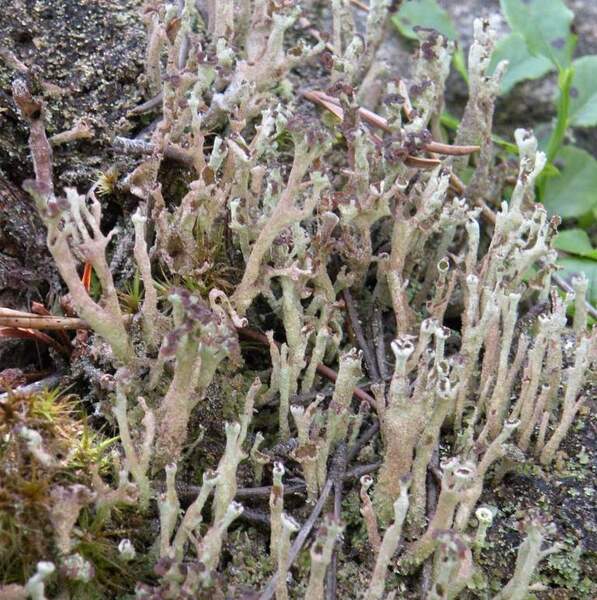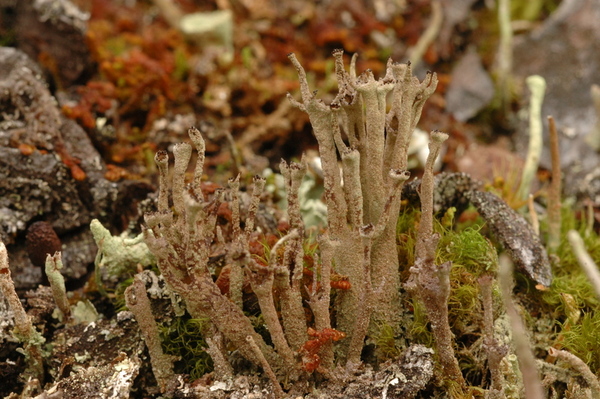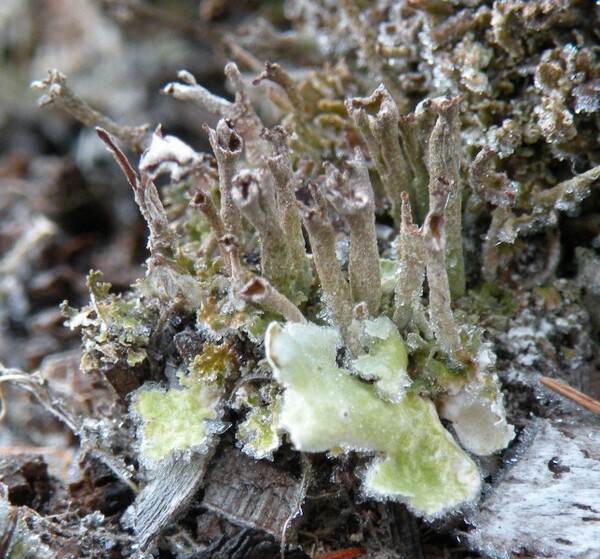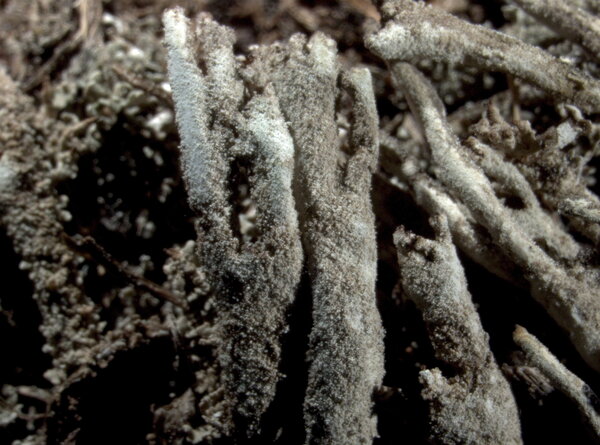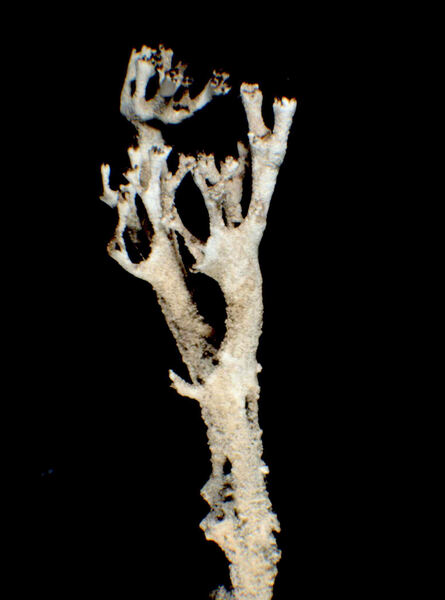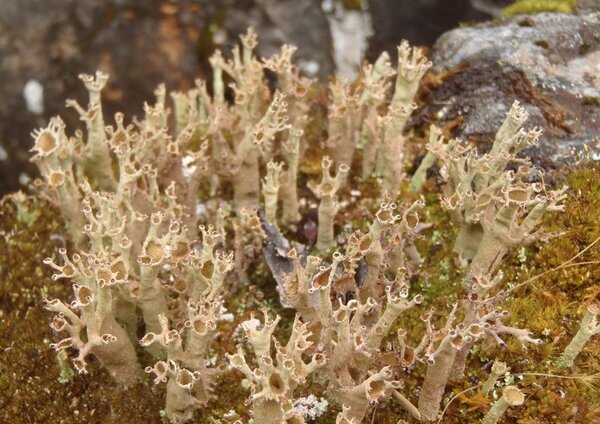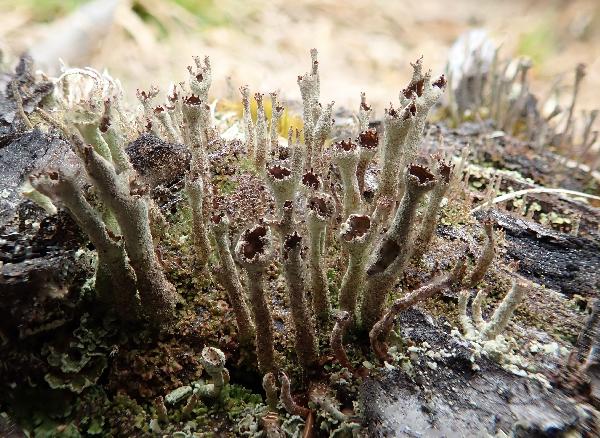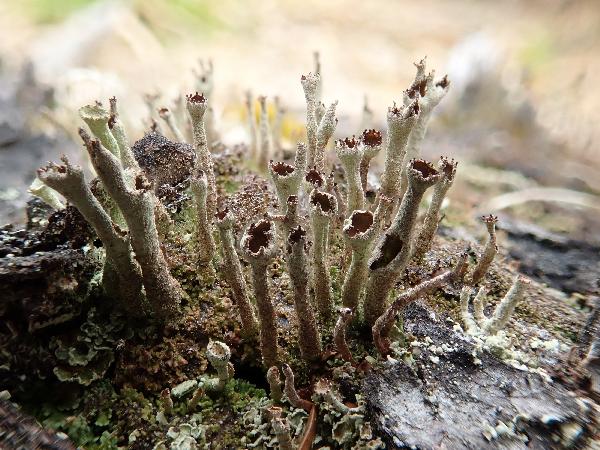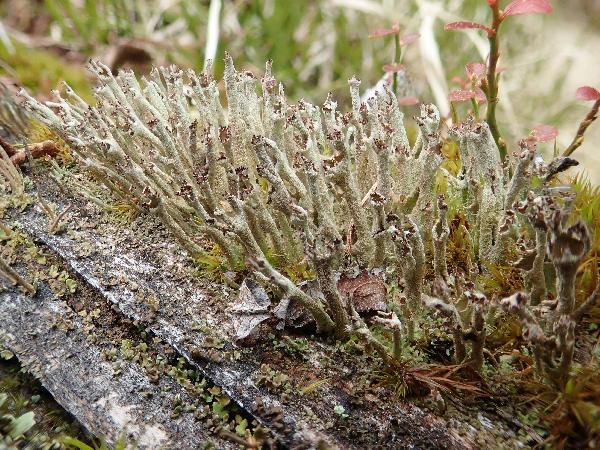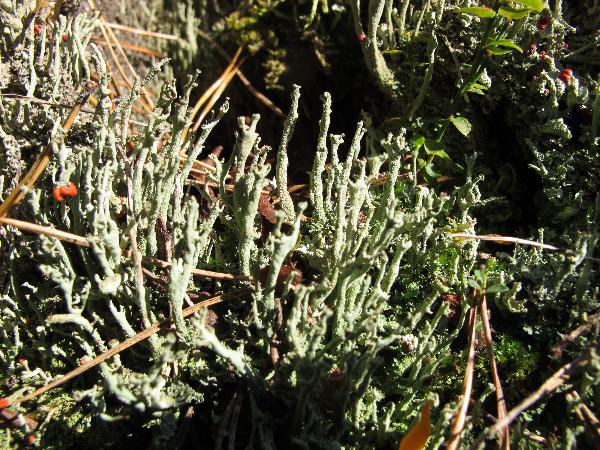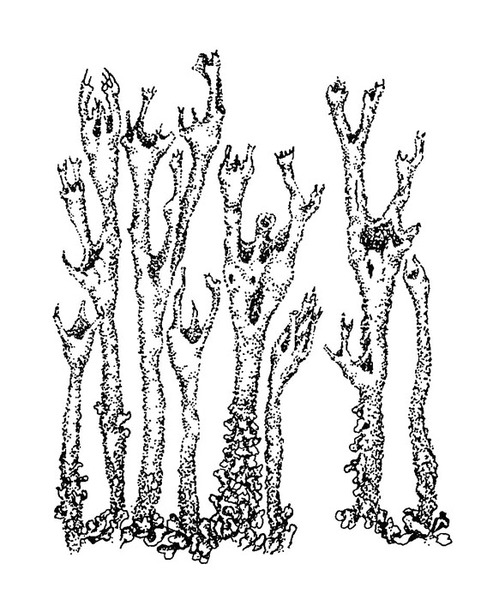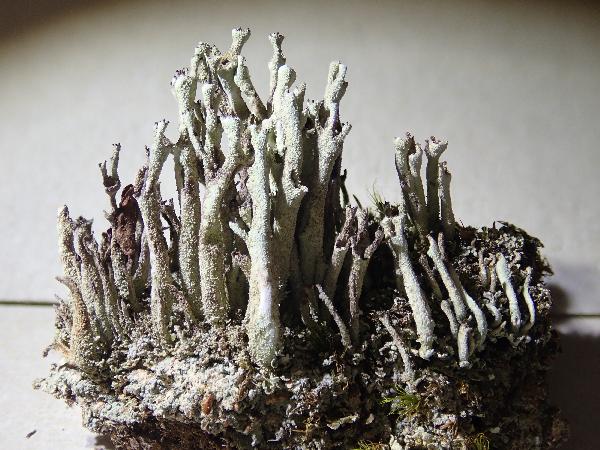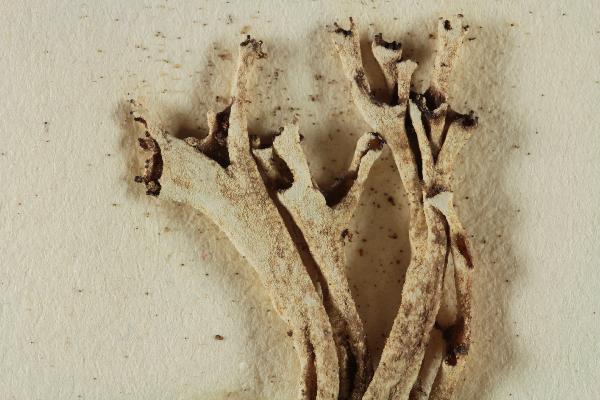Cladonia cenotea (Ach.) Schaer.
Lich. Helv. Spicil., 1, 1: 35, 1823. Basionym: Baeomyces cenoteus Ach. - Meth. Lich.: 345, 1803.
Synonyms:
Description: Primary thallus squamulose, the squamules persistent or evanescent, small (1-3 mm long, 0.5-1.5 mm broad), indented, greyish green to brownish above, white below, sometimes sorediate. Podetia elongate, hollow inside, grey to grey-brown, rarely melanotic at base, corticate only at base, non- or scarcely squamulose, 1-3(-6) cm tall, 2-6 mm thick, unbranched or sparingly branched in upper part, farinose-sorediate in upper part (soredia 17-50 μm in diam.), with narrow, irregular, perforated funnels, the margins often toothed and usually inrolled toward the perforation. Apothecia very rare, brown, convex, mostly marginal on cups. Asci 8-spored, clavate, thickened at apex, with a K/I+ blue tholus and a K/I+ strongly blue outer gelatinous sheath, Cladonia-type. Ascospores 1-celled, hyaline, ellipsoid. Pycnidia frequent, on the margins of funnels, cylindrical, with a reddish jelly. Conidia hyaline, curved. Photobiont chlorococcoid. Spot tests: K-, C-, KC-, P-, UV+ white. Chemistry: squamatic acid in thallus, barbatic acid in apothecia, occasionally traces of thamnolic acid.
Growth form: Fruticose
Photobiont: green algae other than Trentepohlia
Reproductive strategy: mainly asexual, by soredia, or soredia-like structures (e.g. blastidia)
Commonnes-rarity: (info)
Alpine belt: extremely rare
Subalpine belt: very rare
Montane belt: rare
Dry submediterranean belt: very rare
Humid submediterranean belt: rare
Padanian area: absent
pH of the substrata:
1 2 3 4 5
Solar irradiation:
1 2 3 4 5
Aridity:
1 2 3 4 5
Eutrophication:
1 2 3 4 5
Poleotolerance:
0 1 2 3
Altitudinal distribution:
1 2 3 4 5 6
Rarity
absent
extremely rare
very rare
rare
rather rare
rather common
common
very common
extremely common
Loading data...
Occurrence data
Predictive map
 Current prediction (1981-2010)
Current prediction (1981-2010)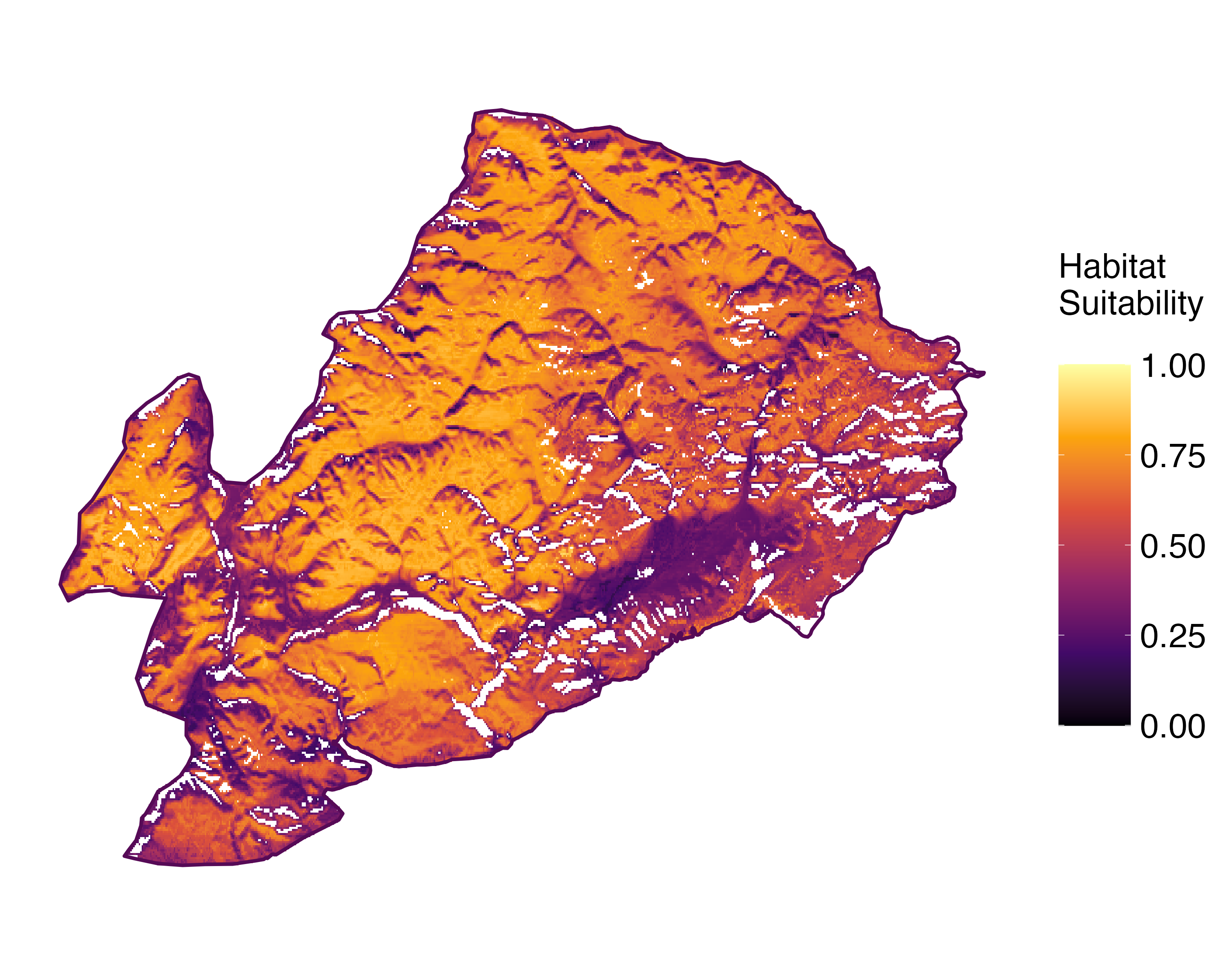 Future prediction (2071-2100) SSP 1-2.6
Future prediction (2071-2100) SSP 1-2.6 Future prediction (2071-2100) SSP 5-8.5Predictive maps according to Francesconi et al. 2025
Future prediction (2071-2100) SSP 5-8.5Predictive maps according to Francesconi et al. 2025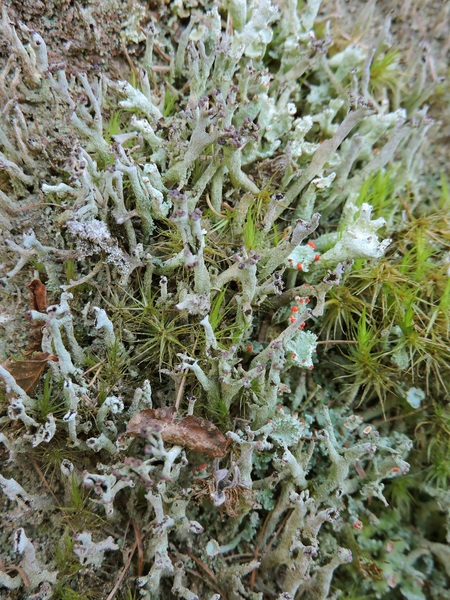
Gabriele Gheza - https://lichenidilombardia.home.blog
Italy, Lombardia, Bergamo, Azzone, 1800 m
27/10/2017
with C. digitata
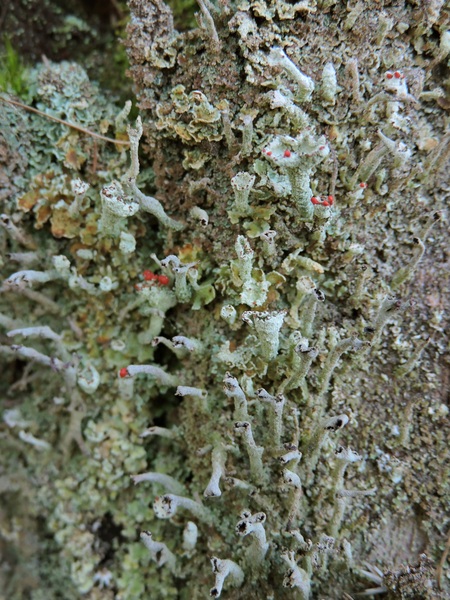
Gabriele Gheza - https://lichenidilombardia.home.blog
Italy, Lombardia, Bergamo, Azzone, 1800 m
27/10/2017
with C. digitata
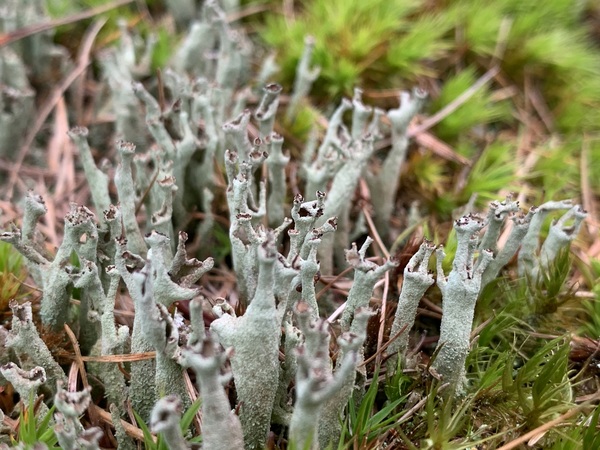
Gabriele Gheza - https://lichenidilombardia.home.blog
Italy, Lombardia, Brescia, Ponte di Legno, 1750 m
08/2020
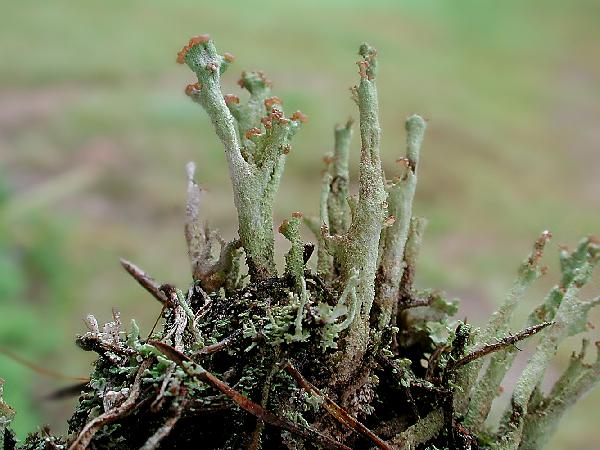
Ulrich Kirschbaum CC BY-SA 4.0 - Source: https://www.thm.de/lse/ulrich-kirschbaum/flechtenbilder
Sweden: Dalarna.
Growth form: Fruticose
Photobiont: green algae other than Trentepohlia
Reproductive strategy: mainly asexual, by soredia, or soredia-like structures (e.g. blastidia)
Commonnes-rarity: (info)
Alpine belt: extremely rare
Subalpine belt: very rare
Montane belt: rare
Dry submediterranean belt: very rare
Humid submediterranean belt: rare
Padanian area: absent
pH of the substrata:
| 1 | 2 | 3 | 4 | 5 |
Solar irradiation:
| 1 | 2 | 3 | 4 | 5 |
Aridity:
| 1 | 2 | 3 | 4 | 5 |
Eutrophication:
| 1 | 2 | 3 | 4 | 5 |
Poleotolerance:
| 0 | 1 | 2 | 3 |
Altitudinal distribution:
| 1 | 2 | 3 | 4 | 5 | 6 |
Rarity
absent
extremely rare
very rare
rare
rather rare
rather common
common
very common
extremely common
Loading data...
Occurrence data
Predictive map
 Current prediction (1981-2010)
Current prediction (1981-2010) Future prediction (2071-2100) SSP 1-2.6
Future prediction (2071-2100) SSP 1-2.6 Future prediction (2071-2100) SSP 5-8.5
Future prediction (2071-2100) SSP 5-8.5Predictive maps according to Francesconi et al. 2025

Gabriele Gheza - https://lichenidilombardia.home.blog
Italy, Lombardia, Bergamo, Azzone, 1800 m
27/10/2017
with C. digitata

Gabriele Gheza - https://lichenidilombardia.home.blog
Italy, Lombardia, Bergamo, Azzone, 1800 m
27/10/2017
with C. digitata

Gabriele Gheza - https://lichenidilombardia.home.blog
Italy, Lombardia, Brescia, Ponte di Legno, 1750 m
08/2020



